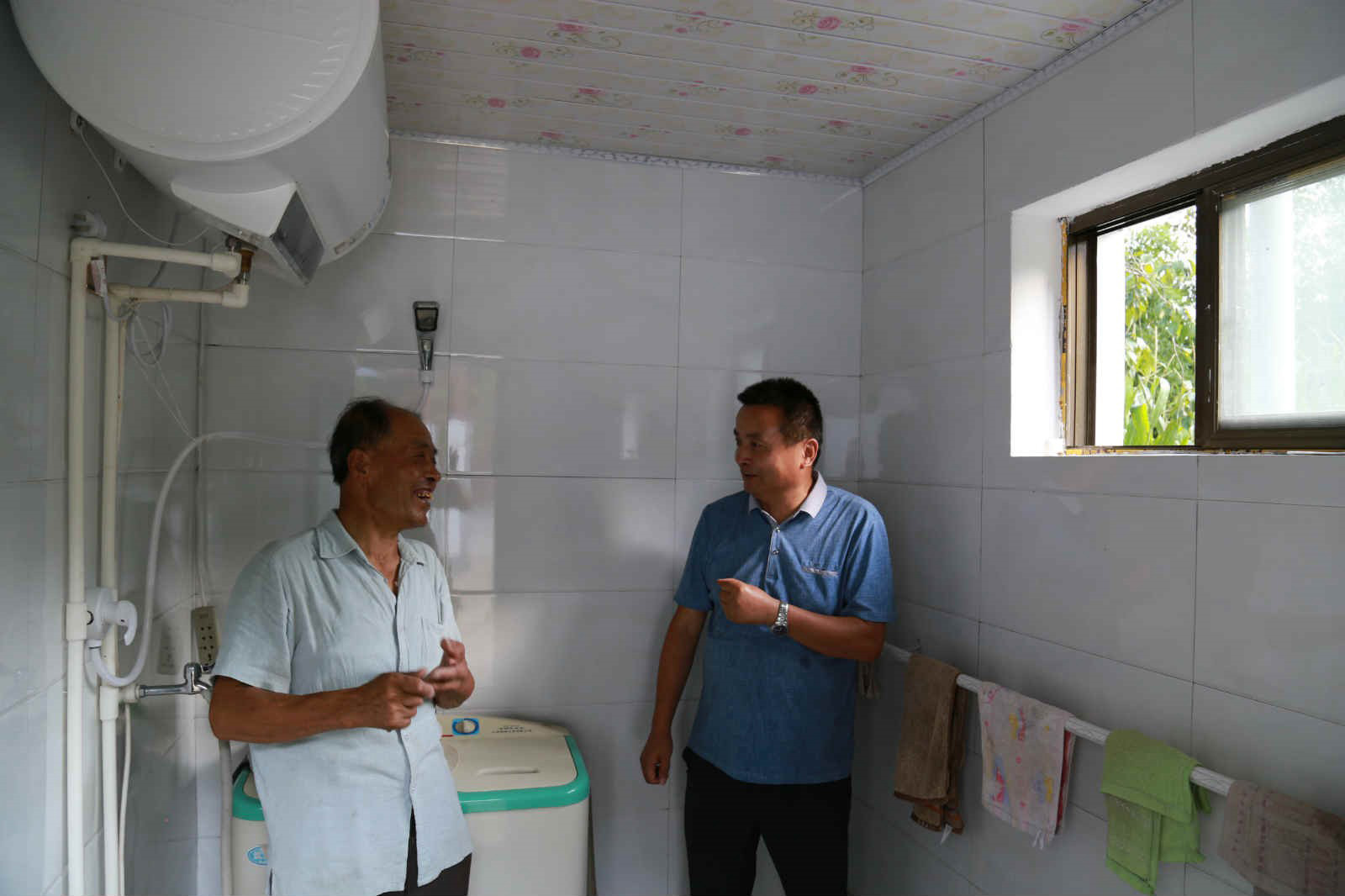

 |
| Wang Wenhua, first secretary for poverty alleviation in Huozhan village, Huixian county, Longnan, northwest China's Gansu province, checks the newly-renovated toilet of a villager, Aug. 14, 2019. (People's Daily Online/Li Xuchun) |
Thanks to China's "toilet revolution", Fan Zengjiu, a villager in the country's Sichuan province, has seen significant improvements on the toilet as well as the living conditions of his family.
"My old toilet was dirty and shabby. It had neither a roof nor a door," said Zeng, who comes from Pingwu township, Jianyang, southwest China's Sichuan, calling it such a pain having to use the toilet in winter, especially in windy days.
Nowadays, however, the toilet of Fan’s family not only has a door, but is neatly tiled, nothing like the dirty and messy one it used to be. “The whole living environment has been upgraded,” Fan said happily.
Fan's toilet is an epitome of numerous toilets renovated because of the country’s "toilet revolution" project implemented during its 13th Five-Year Plan period (2016-2020).
Over the past five years, China has significantly improved the conditions of toilets in tourist destinations and rural areas, both public and family ones.
The central government of China has allocated a huge amount of funds for the "toilet revolution" every year. In 2020 alone, it arranged 7.4 billion yuan ($1.15 billion) to promote the transformation of toilets in villages.
From 2018 to 2020, south China's Guangdong province allocated over 32.9 billion yuan to push forward with projects launched for the construction of beautiful and livable countryside, including the "toilet revolution" project.
Since 2017, Changle district, Fuzhou, southeast China's Fujian province, has newly built or upgraded 391 public toilets in urban and rural areas, among which 53 were built or upgraded in 2020.
“We didn’t have to pay a penny for the upgrading. Manufacturers of toilet fittings have even adjusted their products according to the needs of different families," recalled Liu Yusuo, a villager from Yangqu county, Taiyuan, capital of north China's Shanxi province, adding that his fellow villagers were all very pleased with the toilet transformation.
Lahai village, Xingjie township, Xichou county, southwest China's Yunnan province, has explored a new path for the construction and management of public toilets.
The village took some money from its collective income to renovate over 10 public toilets and improve their sanitary conditions, according to Liu Chaoren, Party branch secretary of the village.
“Each of the villagers has been asked to donate 0.1 yuan every day. Part of the donations is used for the daily cleaning, maintenance, and management of public facilities including public toilets,” Liu added.
In this way, villagers have been more involved in the affair concerning the interests of every one of them. In addition, by paying to hire poor residents in the village to clean public toilets, villagers have not only solved the problem of poor sanitation, but increased the income of the poor.
Various regions in China are also formulating toilet management mechanisms with characteristics.
Dezhou city in east China's Shandong province has included the daily management and maintenance of public toilets into the assessment of rural living environments improvement. Each public toilet in the city is cleaned by a full-time cleaner, whose salary varies with the assessment results.
Nantong, east China's Jiangsu province, has comprehensively introduced a management model where government officials have been designated as chiefs of public toilets. These toilet chiefs are responsible for coordinating, supervising and inspecting the management of rural public toilets under their jurisdiction.
Statistics from the country’s Ministry of Agriculture and Rural Affairs show that more than 60 percent of rural areas in China had built toilets with sound sanitary conditions by the end of 2019.
As of the end of 2020, over 45 percent of agricultural and pastoral areas in southwest China's Tibet autonomous region had built toilets with sound sanitary conditions. The percentages of such toilets in rural areas of China's Henan province and Xinjiang Uygur autonomous region reached 85 percent and 59.29 percent, respectively. In Shandong, 10.75 million rural households had got renovated sanitary toilets by 2020.
China's strong will and determination in promoting the "toilet revolution" are worth admiring, said Brian Arbogast, director of the water, sanitation and hygiene program under the Bill & Melinda Gates Foundation.
After the "toilet revolution" was launched, the Chinese government, enterprises, and society have comprehensively mobilized the Chinese people, and generally improved the construction, management, and services of toilets.
 |

 Award-winning photos show poverty reduction achievements in NE China's Jilin province
Award-winning photos show poverty reduction achievements in NE China's Jilin province People dance to greet advent of New Year in Ameiqituo Town, Guizhou
People dance to greet advent of New Year in Ameiqituo Town, Guizhou Fire brigade in Shanghai holds group wedding
Fire brigade in Shanghai holds group wedding Tourists enjoy ice sculptures in Datan Town, north China
Tourists enjoy ice sculptures in Datan Town, north China Sunset scenery of Dayan Pagoda in Xi'an
Sunset scenery of Dayan Pagoda in Xi'an Tourists have fun at scenic spot in Nanlong Town, NW China
Tourists have fun at scenic spot in Nanlong Town, NW China Harbin attracts tourists by making best use of ice in winter
Harbin attracts tourists by making best use of ice in winter In pics: FIS Alpine Ski Women's World Cup Slalom
In pics: FIS Alpine Ski Women's World Cup Slalom Black-necked cranes rest at reservoir in Lhunzhub County, Lhasa
Black-necked cranes rest at reservoir in Lhunzhub County, Lhasa China's FAST telescope will be available to foreign scientists in April
China's FAST telescope will be available to foreign scientists in April